城区电动汽车充电站布局规划研究
侯 慧,唐俊一,王逸凡,夏晓荣,王 飞,胡鹏飞,谢长君
城区电动汽车充电站布局规划研究
侯 慧1,2,唐俊一1,2,王逸凡1,2,夏晓荣3,王 飞3,胡鹏飞3,谢长君1,2
(1.武汉理工大学自动化学院,湖北 武汉 430070;2.武汉理工大学深圳研究院,广东 深圳 518000;3.国网湖北省电力有限公司荆门供电公司,湖北 荆门 448000)
电动汽车的大量推广必须以科学合理的充电设施规划为基础。提出一种城区电动汽车充电站布局规划方法。首先,在城区电动汽车快充需求分布预测基础上,以充电站内充电机数量、充电站与快充需求点间距离以及充电站间距离为约束,充电站社会年总成本最小为目标,建立兼顾充电站、电动汽车用户以及电网三方利益的充电站选址定容模型。然后,采用Voronoi图联合改进粒子群算法对模型进行求解。通过Voronoi图划分充电站服务区域,再利用改进粒子群算法进行全局寻优,得到规划区域内充电站选址定容最优方案。最后,以某城区为例进行仿真,验证了所提方法的有效性。
电动汽车充电站;选址定容;Voronoi图;改进粒子群算法
0 引言
随着当前环境的持续恶化及化石燃料的日益短缺,电动汽车(Electric Vehicle, EV)正面临广阔的应用空间[1-3]。在“碳达峰”、“碳中和”背景下,我国EV数量保持着快速上升的趋势[4-6]。截至2021年6月,我国EV保有量达到493万辆[7]。充电站作为EV的基础配套设施,影响着EV的应用水平,对其进行科学合理规划,不仅能够减少投资建设费用,减轻EV大量接入对配电网造成的冲击,还能让EV用户享受便捷的充电服务[8],对EV产业发展有着积极促进作用,具有重要的现实意义。
目前国内外学者针对EV充电站规划[9-12]做了大量研究。文献[13]以充电站建设成本和网损成本之和最小为目标构造了充电站最优规划模型。文献[14]提出了一种基于全生命周期成本的EV充/换电站最优规划方法。文献[15]以充电站年投资成本、运行管理成本、网损成本以及电网年加固成本之和最小为目标,建立了考虑多种充电设施的充电站规划模型。但以上研究没有考虑EV用户的利益。文献[16-18]从EV用户充电需求出发,计及充电站与EV用户双方利益,构建了充电站布局规划双层模型。文献[19-20]基于EV用户出行特性建立了充电站选址模型。文献[21]提出了一种综合考虑充电站运营商利益、EV用户充电满意度、交通网通行效率及电网安全约束的充电站选址模型。文献[22]借鉴Hodgson提出的截流选址模型,考虑流量蚕食效应,以充电站截获的总路径流量最大为目标建立了城市外围快充设施选址模型。文献[23]采用K-means聚类算法生成充电需求点,建立了综合考虑用户侧与非用户侧利益的充电站多目标规划模型。但以上研究没有对充电站服务区域进行明确划分。针对上述研究不足,本文从EV快充需求分布预测入手,建立以充电站社会年总成本最小为目标的充电站选址定容模型,采用Voronoi图联合改进粒子群算法对模型进行求解,通过Voronoi图划分充电站服务区域,再使用改进粒子群算法寻找全局最优解。以某城区为例进行仿真分析,验证所提方法的有效性。
1 EV快充需求分布预测


2 EV充电站选址定容数学模型
在EV快充需求分布预测的基础上,本文提出一种EV充电站选址定容数学模型。
2.1 EV充电站选址模型
EV充电站布局规划需要同时考虑充电站运营商、EV用户以及电网公司的利益,本文以充电站年建设运行成本、用户充电途中年损耗成本、配网损耗年成本之和最小为目标[27-28],建立充电站选址模型如式(2)—式(9)所示。








2.2 EV充电站定容模型
充电站内配备的充电机台数既与其服务区域内有快充需求的EV数量有关,还与EV用户到达充电站后能接受的前方排队车辆数有关。充电站内配备的充电机台数可表示为[26]
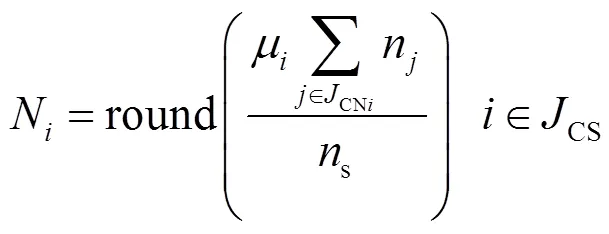
3 EV充电站选址定容模型求解
由于EV充电站选址定容模型中含有充电站站址、充电站与快充需求点间距离、充电站内配备的充电机数量等众多变量,使用常规方法求解该模型比较困难,因此本文选用计算速度快、全局寻优能力强的改进粒子群算法联合Voronoi图[29]对模型进行求解。
3.1 改进粒子群算法


3.2 求解流程
求解流程如图1所示,其主要分为以下几个步骤。
步骤1:根据规划区域内EV总数及各快充需求点常规电力负荷由式(1)确定各快充需求点处EV数量。
步骤3:以充电站站址为生长点作Voronoi图划定各充电站服务区域,根据服务区域内快充EV数量应用式(10)确定充电站容量。

步骤5:是否达到最大迭代次数。是,转步骤7;否,执行步骤6。
步骤6:更新粒子的速度和位置,跳转至步骤3,迭代次数加1。
步骤7:输出社会年总成本最小的规划结果。

图1 Voronoi图与改进粒子群算法联合求解流程图
4 算例分析
4.1 算例描述

图2 规划区域

表1 各功能区电力负荷
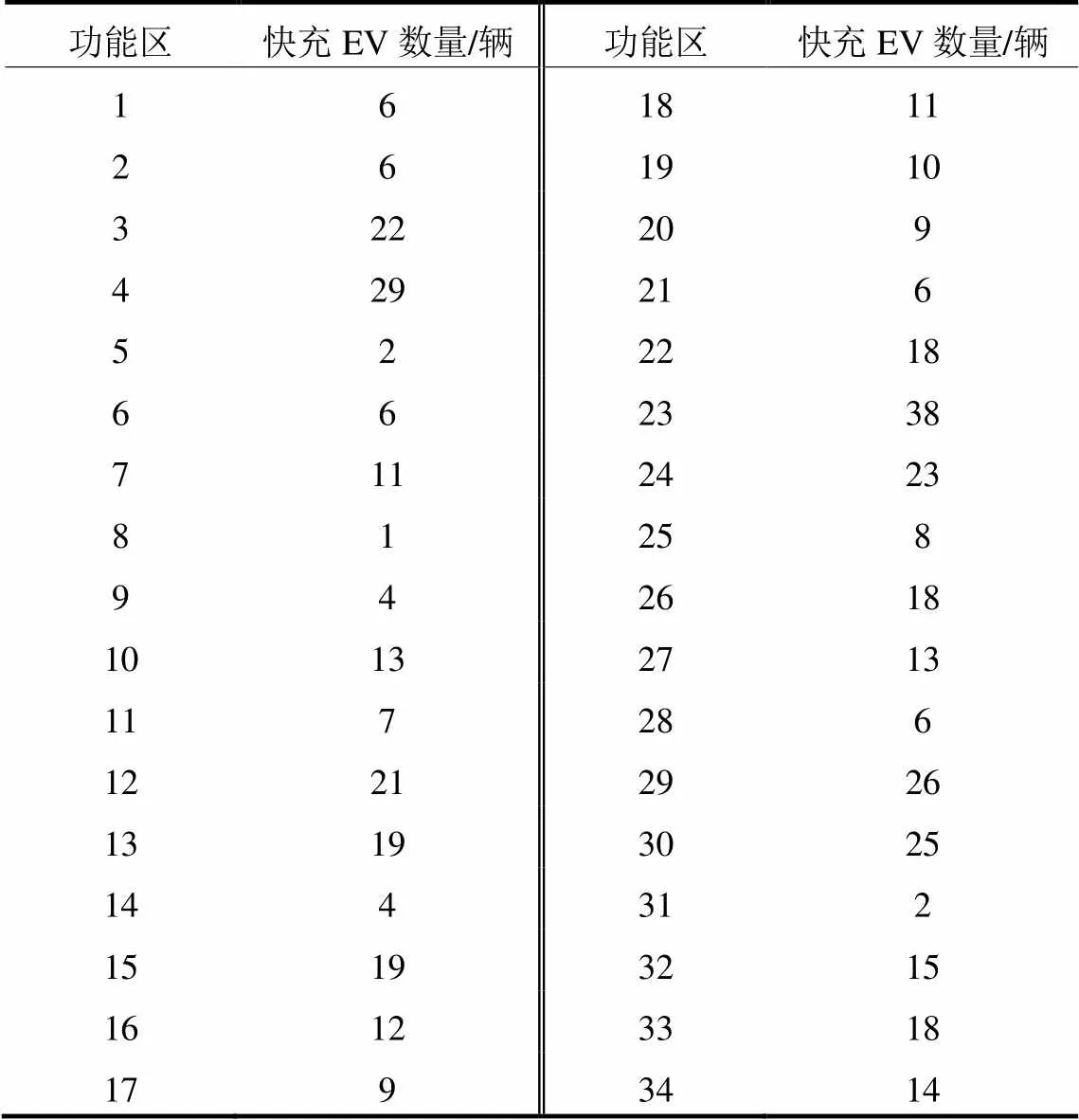
表2 各功能区有快充需求的EV数量
参考文献[27-28],本文取基础投资为200万元,充电机为5万元/台,充电机辅助投资系数为1.5万元/台。充电站折旧年限为20年,贴现率为0.08。年运行维护成本取投资建设成本的15%。EV行驶耗电量为0.3 kWh/km,EV充电电价为1元/kWh,城市道路曲折系数取1.2。充电站购电电价为0.7元/kWh,每天运营时间为20 h,折算至单台配电变压器的铜损及铁损为0.04元/kWh,折算至单台充电机的线路损耗及充电损耗为0.05元/kWh。EV同时到站率为0.6,用户能忍受的单台充电机前方排队车辆数为3辆。充电站内配备的充电机最少为10台,最多为20台。充电站与快充需求点间最大距离为1.5 km,充电站间最小距离为0.5 km。
4.2 仿真分析
由式(10)可知规划区域内共需配备大约90台充电机,因此充电站的建设数量为5~9座。根据图1给出的求解流程,假设粒子群种群数为20,最大迭代次数为300,运用Matlab软件求解不同数量充电站对应的社会年总成本,结果如表3所示。由表3可知,当充电站数量为6座时,社会年总成本最少,为439.14万元。该方案下各充电站站址及其服务区域如图3所示,各充电站内充电机数量及各项成本如表4所示。
图3中,蓝色三角形代表EV充电站,三角形旁边的红色数字为充电站编号。黑色圆点代表EV快充需求点,圆点旁边的蓝色数字为该需求点所属的充电站编号。蓝色直线所划分区域为各EV充电站服务区域。各充电站具体服务情况为:1号充电站服务4个需求点;2号充电站服务4个需求点;3号充电站服务7个需求点;4号充电站服务7个需求点;5号充电站服务5个需求点;6号充电站服务7个需求点。从图3可以看出,各充电站在规划区域内布局合理,靠近快充需求点中心,用户能享受便利的充电服务,并且各充电站服务区域划分明确。

表3 各规划方案的社会年总成本

图3 充电站站址及其服务区域(改进粒子群算法)
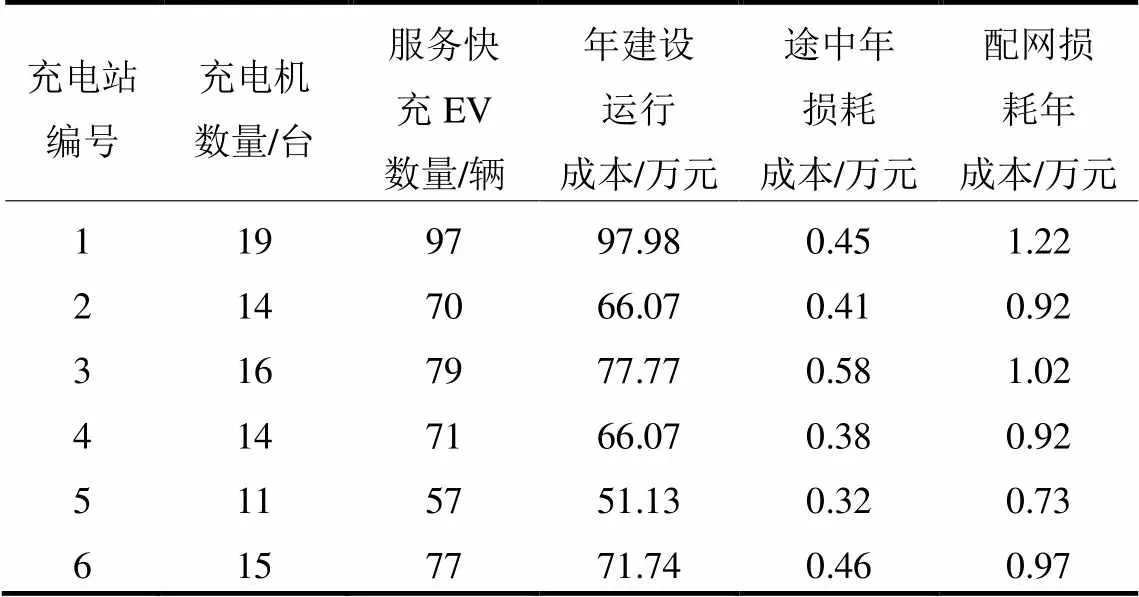
表4 充电站最优规划结果
从表4可以看到,各充电站内配备的充电机台数不同,充电机台数与充电站服务的快充EV数量相匹配。各充电站年建设运行成本及配网损耗年成本与站内配备的充电机台数成正比,用户充电途中年损耗成本虽然相对较小,但是反映了用户前往充电站的便捷程度。
为了验证改进粒子群算法具有更好的全局寻优能力,本文运用粒子群算法联合Voronoi图对充电站选址定容模型进行求解,仿真结果如图4及表5所示,两种算法的迭代过程如图5所示。
从表5可以看到,使用改进粒子群算法得到的规划结果中社会年总成本更低,规划区域内共需配备89台充电机。而使用粒子群算法得到的规划结果中规划区域内共需配备90台充电机,这导致了充电站年建设运行成本及配网损耗年成本的增加。从图5可以看到,改进粒子群算法经过大约85次迭代后得到收敛,粒子群算法经过大约190次迭代后才得到收敛,这表明改进粒子群算法收敛速度更快。
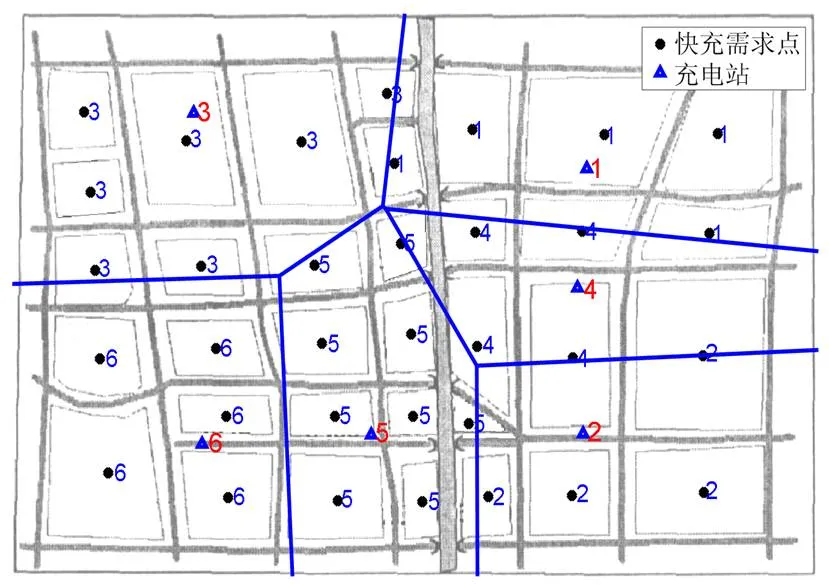
图4 充电站站址及其服务区域(粒子群算法)
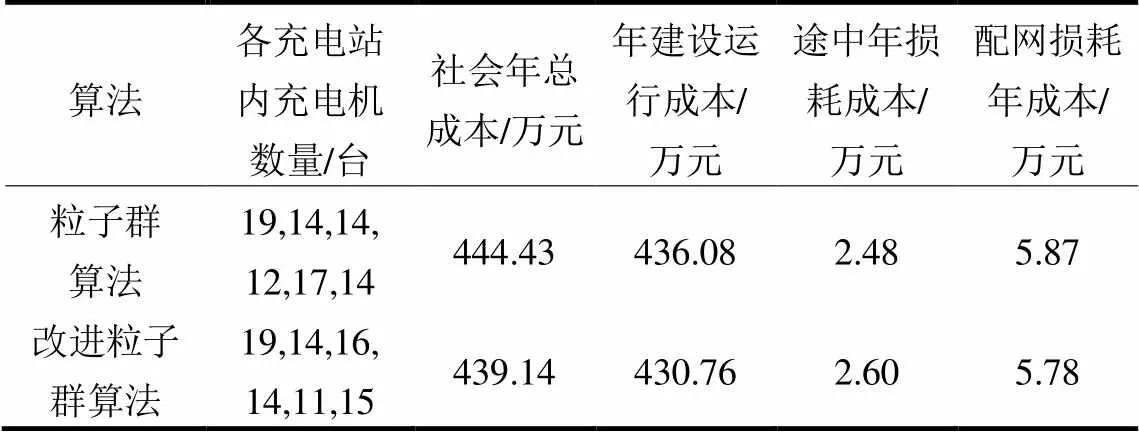
表5 仿真结果对比

图5 迭代过程
5 结论
本文同时兼顾充电站、EV用户以及电网三方利益,以充电站年建设运行成本、用户充电途中年损耗成本、配网损耗年成本之和最小为目标建立充电站选址定容模型。以充电站站址为Voronoi图生长点,以生成的Voronoi图划分充电站服务区域,根据服务区域内快充EV数量确定充电站容量,再使用改进粒子群算法寻找全局最优解。仿真结果表明:本文所提方法可使充电站在规划区域内布局合理,靠近快充需求点中心,用户能享受便利的充电服务,并且各充电站服务区域划分明确。与粒子群算法相比,改进粒子群算法能够以更少的迭代次数找到总成本更低的规划方案。
[1] 姚颖蓓, 陆建忠, 傅业盛, 等. 华东地区电动汽车发展趋势及用电需求预测[J]. 电力系统保护与控制, 2021, 49(4): 141-145.
YAO Yingbei, LU Jianzhong, FU Yesheng, et al. Electric vehicle development trends and electricity demand forecast in East China[J]. Power System Protection and Control, 2021, 49(4): 141-145.
[2] HUANG Z, FANG B, DENG J. Multi-objective optimization strategy for distribution network considering V2G-enabled electric vehicles in building integrated energy system[J]. Protection and Control of Modern Power Systems, 2020, 5(1): 48-55.
[3] 周衍涛, 戴军, 苑惠丽, 等. 城市电动汽车充电设施需求预测与规划布局研究[J]. 电力系统保护与控制, 2021, 49(24): 177-187.
ZHOU Yantao, DAI Jun, YUAN Huili, et al. Demand forecasting and planning layout of urban electric vehicle charging facilities[J]. Power System Protection and Control, 2021, 49(24): 177-187.
[4] 欧阳明高. 面向碳中和的新能源汽车创新与发展[J]. 科学中国人, 2021, 11: 26-31.
OUYANG Minggao. Innovation and development of new energy vehicles for carbon neutralization[J]. Scientific Chinese, 2021, 11: 26-31.
[5] 刘坚. 电动汽车储能技术应用潜力及功能定位研究[J]. 全球能源互联网, 2020, 3(1): 44-50.
LIU Jian. An analysis on the application potential and position of electric vehicle energy storage[J]. Journal of Global Energy Interconnection, 2020, 3(1): 44-50.
[6] 张卫国, 宋杰, 陈良亮, 等. 满足电动汽车充电需求的台区柔性资源分布式协调控制[J]. 电测与仪表, 2021, 58(7): 27-35.
ZHANG Weiguo, SONG Jie, CHEN Liangliang, et al. Distributed coordination control of station flexible resources based on electric vehicle charging demand[J]. Electrical Measurement & Instrumentation, 2021, 58(7): 27-35.
[7] 中商情报网. 2021年上半年中国新能源汽车保有量603万辆纯电动汽车保有量占比81.68%[EB/OL]. https: //baijiahao.baidu.com/s?id=1704613490357238960&wfr=spider&for=pc.
China Business Information Network. In the first half of 2021, there are 6.03 million new energy vehicles in China, of which electric vehicles account for 81.68%[EB/OL]. https: //baijiahao. baidu. com/s?id=1704613490357238960 &wfr=spider&for=pc.
[8] DAS H S, RAHMAN M M, LI S, et al. Electric vehicles standards, charging infrastructure, and impact on grid integration: a technological review[J]. Renewable and Sustainable Energy Reviews, 2020, 120: 1-27.
[9] 徐雄军, 朱溥楠, 徐鸣, 等. 考虑安全效能成本的电动汽车充电站多目标规划方法[J]. 电网与清洁能源, 2021, 37(12): 132-138.
XU Xiongjun, ZHU Punan, XU Ming, et al. A multi objective programming method of electric vehicle charging stations considering safety efficiency cost[J]. Power System and Clean Energy, 2021, 37(12): 132-138.
[10]张端鸿, 史一炜, 冯冬涵, 等. 含多类型充电设施的城市电动汽车充电站群协同规划方法[J]. 电测与仪表, 2020, 57(20): 60-66, 80.
ZHANG Duanhong, SHI Yiwei, FENF Donghan, et al. A cooperative planning method of urban electric vehicle charging station group with multi-type charging facilities[J]. Electrical Measurement & Instrumentation, 2020, 57(20): 60-66, 80.
[11]王延杰, 徐国智, 赵振杰. 基于投资效益分析的电动汽车充电设施建设策略与应用研究[J]. 供用电, 2021, 38(2): 77-85.
WANG Yanjie, XU Guozhi, ZHAO Zhenjie. Research on construction strategy and application of electric vehicle charging facilities based on investment benefit analysis[J]. Distribution & Utilization, 2021, 38(2): 77-85.
[12]洪彬倬, 冯乙峰, 阳细斌, 等. 考虑交通信息与配电网结构的充电站规划[J]. 广东电力, 2020, 33(2): 101-108.
HONG Binzhuo, FENG Yifeng, YANG Xibin, et al. Charging station planning considering traffic information and distribution network structure[J]. Guangdong Electric Power, 2020, 33(2): 101-108.
[13] LIU Z, WEN F, LEDWICH G. Optimal planning of electric-vehicle charging station in distribution systems[J]. IEEE Transactions on Power Delivery, 2013, 28(1): 102-110.
[14] ZHENG Y, DONG Z Y, XU Y, et al. Electric vehicle battery charging/swap stations in distribution systems: comparison study and optimal planning[J]. IEEE Transactions on Power Systems, 2014, 29(1): 221-229.
[15] LUO L, GU W, ZHOU S, et al. Optimal planning of electric vehicle charging stations comprising multi-types of charging facilities[J]. Applied Energy, 2018, 226: 1087-1099.
[16] ZENG B, DONG H, SIOSHANSI R, et al. Bilevel robust optimization of electric vehicle charging stations with distributed energy resources[J]. IEEE Transactions on Industry Applications, 2020, 56(5): 5836-5847.
[17] 所丽, 向驰, 唐巍, 等. 均衡不同主体利益的集中型充电站多目标二层规划[J]. 电力系统自动化, 2016, 40(12): 100-107.
SUO Li, XIANG Chi, TANG Wei, et al. Multi-objective bi-level programming of centralized charging station considering benefits balance for different subjects[J]. Automation of Electric Power Systems, 2016, 40(12): 100-107.
[18] 谭洋洋, 杨洪耕, 徐方维, 等. 基于投资收益与用户效用耦合决策的电动汽车充电站优化配置[J]. 中国电机工程学报, 2017, 37(20): 5951-5960.
TAN Yangyang, YANG Honggeng, XU Fangwei, et al. Optimal allocation of charging station for electric vehicle based on coupled decision of investment benefit and user utility[J]. Proceedings of the CSEE, 2017, 37(20): 5951-5960.
[19] 徐青山, 蔡婷婷, 刘瑜俊, 等. 考虑驾驶人行为习惯及出行链的电动汽车充电站站址规划[J]. 电力系统自动化, 2016, 40(4): 59-65, 77.
XU Qingshan, CAI Tingting, LIU Yujun, et al. Location planning of charging stations for electric vehicles based on drivers’ behaviours and travel chain[J]. Automation of Electric Power Systems, 2016, 40(4): 59-65, 77.
[20] 付凤杰, 方雅秀, 董红召, 等. 基于历史行驶路线的电动汽车充电站布局优化[J]. 电力系统自动化, 2018, 42(12): 72-80.
FU Fengjie, FANG Yaxiu, DONG Hongzhao, et al. Optimized allocation of charging stations for electric vehicles based on historical trajectories[J]. Automation of Electric Power Systems, 2018, 42(12): 72-80.
[21] KONG W, LUO Y, FENG G, et al. Optimal location planning method of fast charging station for electric vehicles considering operators, drivers, vehicles, traffic flow and power grid[J]. Energy, 2019, 186: 1-13.
[22] 沙迪. 城市电动汽车充电设施分层次选址规划及定容方法研究[D]. 南京: 东南大学, 2017.
SHA Di. Research on the hierarchical location-sizing problem of electric vehicle charging infrastructure deployment in the city[D]. Nanjing: Southeast University, 2017.
[23] 臧海祥, 舒宇心, 傅雨婷, 等. 考虑多需求场景的城市电动汽车充电站多目标规划[J]. 电力系统保护与控制, 2021, 49(5): 67-80.
ZANG Haixiang, SHU Yuxin, FU Yuting, et al. Multi-objective planning of an urban electric vehicle charging station considering multi demand scenarios[J]. Power System Protection and Control, 2021, 49(5): 67-80.
[24] 朱黎明. 基于空间负荷预测和电动汽车快充需求预测的充电站选址规划研究[D]. 武汉: 华中科技大学, 2016.
ZHU Liming. Study of charging station location planning based on spatial load forecasting and electric vehicles fast charging demand forecasting[D]. Wuhan: Huazhong University of Science and Technology, 2016.
[25] TANG D, WANG P. Probabilistic modeling of nodal charging demand based on spatial-temporal dynamics of moving electric vehicles[J]. IEEE Transactions on Smart Grid, 2015, 7(2): 627-636.
[26] 熊虎, 向铁元, 荣欣, 等. 电动汽车电池更换站布局的最优规划[J]. 电力自动化设备, 2012, 32(9): 1-6.
XIONG Hu, XIANG Tieyuan, RONG Xin, et al. Optimal allocation of electric vehicle battery swap stations[J]. Electric Power Automation Equipment, 2012, 32(9): 1-6.
[27] 熊虎, 向铁元, 祝勇刚, 等. 电动汽车公共充电站布局的最优规划[J]. 电力系统自动化, 2012, 36(23): 65-70.
XIONG Hu, XIANG Tieyuan, ZHU Yonggang, et al. Electric vehicle public charging stations location optimal planning[J]. Automation of Electric Power Systems, 2012, 36(23): 65-70.
[28] 艾欣, 李一铮, 王坤宇, 等. 基于混沌模拟退火粒子群优化算法的电动汽车充电站选址与定容[J]. 电力自动化设备, 2018, 38(9): 9-14.
AI Xin, LI Yizheng, WANG Kunyu, et al. Locating and sizing of electric vehicle charging station based on chaotic simulated annealing particle swarm optimization algorithm[J]. Electric Power Automation Equipment, 2018, 38(9): 9-14.
[29] OTHMAN A M, GABBAR H A, PINO F, et al. Optimal electrical fast charging stations by enhanced descent gradient and Voronoi diagram[J]. Computers and Electrical Engineering, 2020, 83: 1-14.
[30] XU G. An adaptive parameter tuning of particle swarm optimization algorithm[J]. Applied Mathematics and Computation, 2013, 219(9): 4560-4569.
[31] 严干贵, 刘华南, 韩凝晖, 等. 计及电动汽车时空分布状态的充电站选址定容优化方法[J]. 中国电机工程学报, 2021, 41(18): 6271-6284.
YAN Gangui, LIU Huanan, HAN Ninghui, et al. An optimization method for location and capacity determination of charging stations considering spatial and temporal distribution of electric vehicles[J]. Proceedings of the CSEE, 2021, 41(18): 6271-6284.
Layout planning of electric vehicle charging stations in urban areas
HOU Hui1, 2, TANG Junyi1, 2, WANG Yifan1, 2, XIA Xiaorong3, WANG Fei3, HU Pengfei3, XIE Changjun1, 2
(1. School of Automation, Wuhan University of Technology, Wuhan 430070, China; 2. Shenzhen Research Institute, Wuhan University of Technology, Shenzhen 518000, China; 3. Jingmen Power Supply Company, State Grid Hubei Electric Power Co., Ltd., Jingmen 448000, China)
The large-scale promotion of electric vehicles must be based on scientific planning of charging facilities. A layout planning method for electric vehicle charging stations in urban areas is proposed. First, taking the number of chargers in a charging station, the distance between the charging station and fast charging demand point, and the distance between charging stations as constraints, a siting and sizing model with the goal of minimizing the social annual cost of the charging stations is established. This is based on the prediction of electric vehicle fast charging demand distribution in urban areas. This model considers the interests of charging station, electric vehicle users and the power grid. Then, the model is analyzed by a Voronoi diagram combined with an improved particle swarm optimization algorithm. The service area of the charging station is divided by the Voronoi diagram, and the optimal solution is found by improved particle swarm optimization algorithm. In this way, the optimal siting and sizing plan of charging stations in the planning area is obtained. Finally, an urban area is taken as an example to verify the effectiveness of the proposed method.
electric vehicle charging station; siting and sizing planning; Voronoi diagram; improved particle swarm optimization algorithm
10.19783/j.cnki.pspc.226008
国家自然科学基金项目资助(52177110);深圳市科技计划资助(JCYJ20210324131409026);国网荆门供电公司项目资助(SGHBJM00FCJS2100782)
This work is supported by the National Natural Science Foundation of China (No. 52177110).
2021-07-31;
2021-10-25
侯 慧(1981—),女,博士,副教授,研究方向为电力系统风险评估、能源互联网、电动汽车与电网互动等;E-mail: husthou@126.com
唐俊一(1997—),男,硕士研究生,研究方向为电动汽车充电设施规划与电网灾后恢复;E-mail: tangjunyi@ whut.edu.cn
王逸凡(1997—),男,硕士研究生,研究方向为电动汽车优化调度。E-mail: wangyifan197106@163.com
(编辑 许 威)

